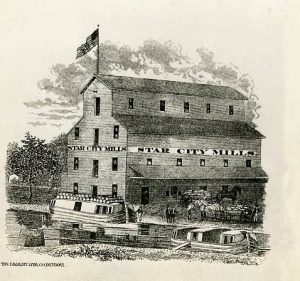Lafayette, Indiana- Star City of the West by Alameda McCollough
[Editor’s note: the opening sentence of this article is as true today as it was when Miss McCollough wrote this piece in 1974 for her Weatenotes column, “Let’s Go See.” Just recently we used this reference in response to a request from a local radio newscaster. It reminded us of what a captivating person Miss McCollough was, and how her love for history illuminated everything she did. Enjoy with us again the words of the lady who served as TCHA’s Curator from 1939 to 1974]
A question often asked of local historians has to do with the origin of the sobriquet “Star City of the West” in connection with our town during earlier days, but in reply, one has to fall back on tradition rather than known fact in explaining claim to such a fanciful title. At this date (1974) no creditable source has appeared to identify the person(s) who might have coined this bit of fantasy, so one must rationalize its poetic nature from the prevailing spirit of the times and the few known facts about the town.
In 1826, within a year after the founding of Lafayette, a small river steamboat, “The Bold Eton,” made its way up the Wabash and docked at the crude little wharf on lower Main Street in William Digby’s scrawny town of such ambitious name. With this momentous appearance, the era of water transportation began, which was to culminate in the decade of the 1850s with Lafayette emerging as the principal river town on the upper Wabash, located at the head of navigation on the river, and, for all practical purposes, the terminus of shipping on the Wabash & Erie Canal. Such a strategic location in a vast and fertile agricultural area of middle Indiana could do no less than create wealth, both real and personal, which was to rank Lafayette high in per capita status among other cities of the nation for years to come.

Cincinnati was known far and wide as the undisputed “Queen City of the West,” but not to be outdone, there began to be heard as early as the 1830s rival claims of Lafayette as the “Star City of the West,” and, brash or not, Indiana was the West when this claim first rose aloft and Lafayette-ians strove mightily to give permanence to their brags about its superiority to any other town.
One does not overlook personalities in the coining of such terms and there were several in the town of those days fully capable of describing it in terms of such poetic flights of fancy, for despite its rough appearance, the townspeople included a surprising number of well-educated men in the classical tradition. Among them were Albert S. White and his young partner in the practice of law, Rufus Lockwood, whose flamboyant oratory became almost a legend before he went to California in the Gold Rush. There was also Dr. Samuel R. Johnson, the beloved first pastor of St. John’s Episcopal Church, whose refining influence was immeasurable. Sandford C. Cox, our first historian, neglected to mention who first loosed upon the vapors of the Wabash the ethereal name for Lafayette as “The Star of the West,” though it was in common use during the time of which he wrote and appeared frequently in the newspapers in praise of local exploits.





